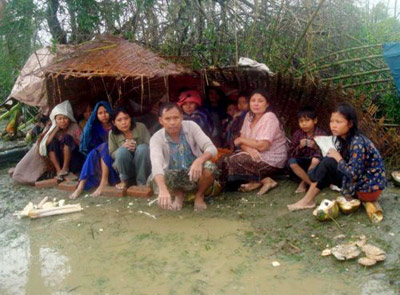Asia suffers severe climate change
In 2008 the earth's climate was colder than the previous year, but it is still warming and climate change can kill millions of people in Asia, which is heavily influenced by the situation, according to the Meteorological Organization's warning. world (WMO).

Millions of Myanmar people lost their homes because of super typhoon Nargis.Photo: wordpress.com.
In the Pacific, Japan for the first time since 2001 has escaped the attack of many anonymous storms due to La Nina's impact on ocean surface temperature in the second half of 2007. Agencies Hydro-meteorology only recorded 22 storms in the northwest Pacific, while the annual average is 27.
Meanwhile in the Bay of Bengal, the largest super typhoon Nargis in Asia in 17 years has flooded into Myanmar and killed nearly 100,000 people last year. According to experts, Nargis is an extremely unusual storm and most of the storms in Asia follow the west-east orbit before turning north, while Nargis goes in the opposite direction.
But that is not the only unusual weather phenomenon in 2008 in Asia. Southern Iran and Oman were also attacked by many powerful tropical storms. Extraordinarily heavy rains during the rainy season in India, Pakistan and Vietnam killed more than 2,600 people last year and pushed more than 10 million people into the scene.
Despite the increase in rainfall and storms, there will be more areas in Asia facing droughts due to water shortages, including the Mediterranean and large areas of Central Asia. High rains in high latitudes can cause floods. Asia and countries near the Pacific must also learn to cope with rising sea levels due to the greenhouse effect. WMO said that every year the sea level increased by 3 cm and the disaster would appear when it increased by a few more centimeters.
Papua New Guinea had declared a state of emergency in early December 2008 after several hundred thousand people in Manus province in the north had to flee their homes due to sea level rise. In many other parts of the Pacific, many island nations are seeking to buy land in another country to relocate land-losing communities due to sea level rise. 'It is another consequence of the greenhouse effect. Its shadow is coming right before our eyes , 'said Omar Baddour, a WMO scientist.
Meanwhile, the strongest snowfall in the United States and Canada during the past 30 years has made people suspicious of climate warmer warming that global temperatures are falling. A newspaper in the UK has run a huge row: '2008 is not the year of the greenhouse effect'. The newspaper said: 'The global average temperature has fallen so sharply that the decline is enough to offset the increase in the 20th century.'
But WMO gives data to prove the opposite. The organization agrees that the global average temperature in 2008 has decreased compared to previous years, but that is due to the La Nina phenomenon (reducing ocean surface temperature) in the second half of 2007.
In a recent report, WMO affirmed that 2008 was at the bottom of the list of the 10 hottest years in 150 years. 'The warming trend still dominates the global climate , ' commented Michel Jarraud, WMO secretary general. According to WMO, the average temperature in 2008 was 14.31 degrees Celsius, lower than 2007 but higher than 1961 (0.31 degrees C) and 1990 (0.56 degrees C).
WMO stated that the moderate weather will be the main trend in the first months of 2009 because there are no La Nina or El Nino (the situation of increasing the surface temperature of the ocean). The rest of 2009 depends on the effects of these two phenomena. Severe weather is raging in many parts of the world, including flash floods, snow storms, and hot sunshine. Meanwhile, the area of ice in the Arctic Ocean in the summer has fallen to its lowest level since 1979.
- Announcing a map of climate change impacts in Southeast Asia
- Southeast Asia is severely affected by climate change
- Asia has been affected by climate change from 34 million years ago
- The cause of unusual heat in Asia
- This is how Dubai copes with climate change
- Climate change brings rain to Africa
- Southeast Asia will be the region most heavily affected by climate change
- What is Climate Change?
- Drought in the Amazon forest causes climate change
- Tornadoes will be more and more intense in the next century
- Red alert for disaster due to climate change
- Dolphins are in tears because of the drought
 Is the magnetic North Pole shift dangerous to humanity?
Is the magnetic North Pole shift dangerous to humanity? Washington legalizes the recycling of human bodies into fertilizer
Washington legalizes the recycling of human bodies into fertilizer Lightning stone - the mysterious guest
Lightning stone - the mysterious guest Stunned by the mysterious sunset, strange appearance
Stunned by the mysterious sunset, strange appearance